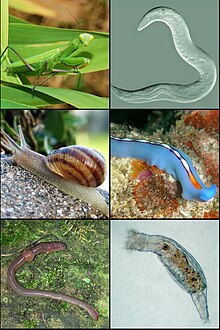Protostome
| Protostomes Temporal range:
| |
|---|---|
 | |
| Scientific classification | |
| Domain: | Eukaryota |
| Kingdom: | Animalia |
| Subkingdom: | Eumetazoa |
| Clade: | ParaHoxozoa |
| Clade: | Bilateria |
| Clade: | Nephrozoa |
| (unranked): | Protostomia Grobben, 1908 |
| Superphyla | |
Protostomia (
Together with the Deuterostomia and
Protostomy
In animals at least as complex as
Protostome and deuterostome embryos differ in several other ways. Many protostomes (the Spiralia clade) undergo spiral cleavage during cell division instead of radial cleavage.[5] Spiral cleavage happens because the cells' division planes are angled to the polar major axis, instead of being parallel or perpendicular to it. Another difference is that secondary body cavities (coeloms) generally form by schizocoely, where the coelom forms out of a solid mass of embryonic tissue splitting away from the rest, instead of by enterocoelic pouching, where the coelom would otherwise form out of in-folded gut walls.[6]
Evolution
The common ancestor of protostomes and deuterostomes was evidently a worm-like aquatic animal of the Ediacaran. The two clades diverged about 600 million years ago. Protostomes evolved into over a million species alive today, compared to ca. 73,000 deuterostome species.[7]
Protostomes are divided into the
| Bilateria |
| ||||||||||||||||||
See also
- Embryological origins of the mouth and anus
- Urbilaterian, a hypothethical common ancestor to Protostomes and Deuterostomes
References
- ^ a b c Hejnol, A.; Martindale, M. Q. (2009). "The mouth, the anus, and the blastopore - open questions about questionable openings". In M. J. Telford; D. T. J. Littlewood (eds.). Animal Evolution — Genomes, Fossils, and Trees. pp. 33–40.
- S2CID 90795.
- PMID 19759036.
- ISBN 978-0-521-83762-0.
- PMID 9223303.
- ISBN 978-0-85229-961-6.
- ^ The Invertebrate tree of life, Giribet & Edgecombe, 2020; p.155
- S2CID 32169826.
- PMID 28377584.
- S2CID 205239797.
- ^ "Palaeos Metazoa: Ecdysozoa". palaeos.com. Retrieved 2017-09-02.
- PMID 26605063.
- PMID 18192191.
External links
 Media related to Protostomia at Wikimedia Commons
Media related to Protostomia at Wikimedia Commons



